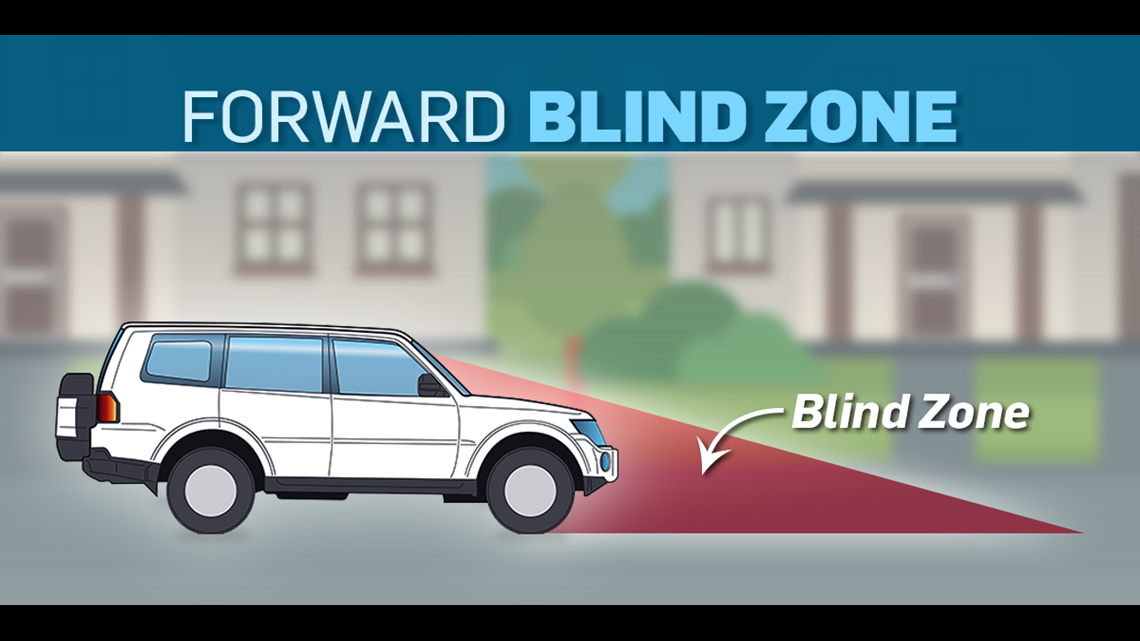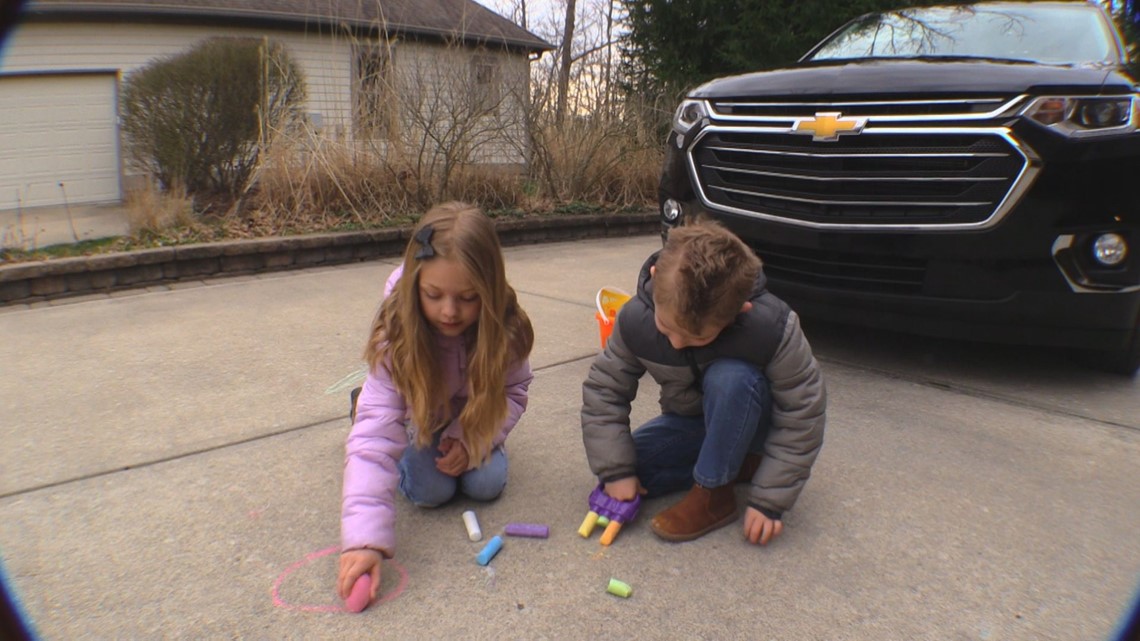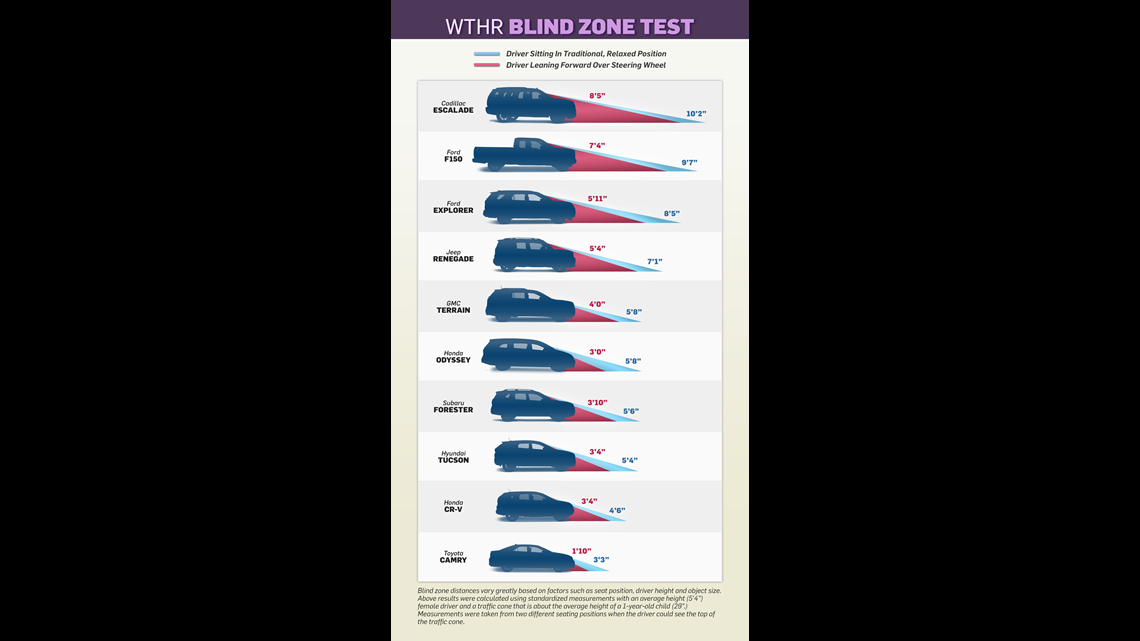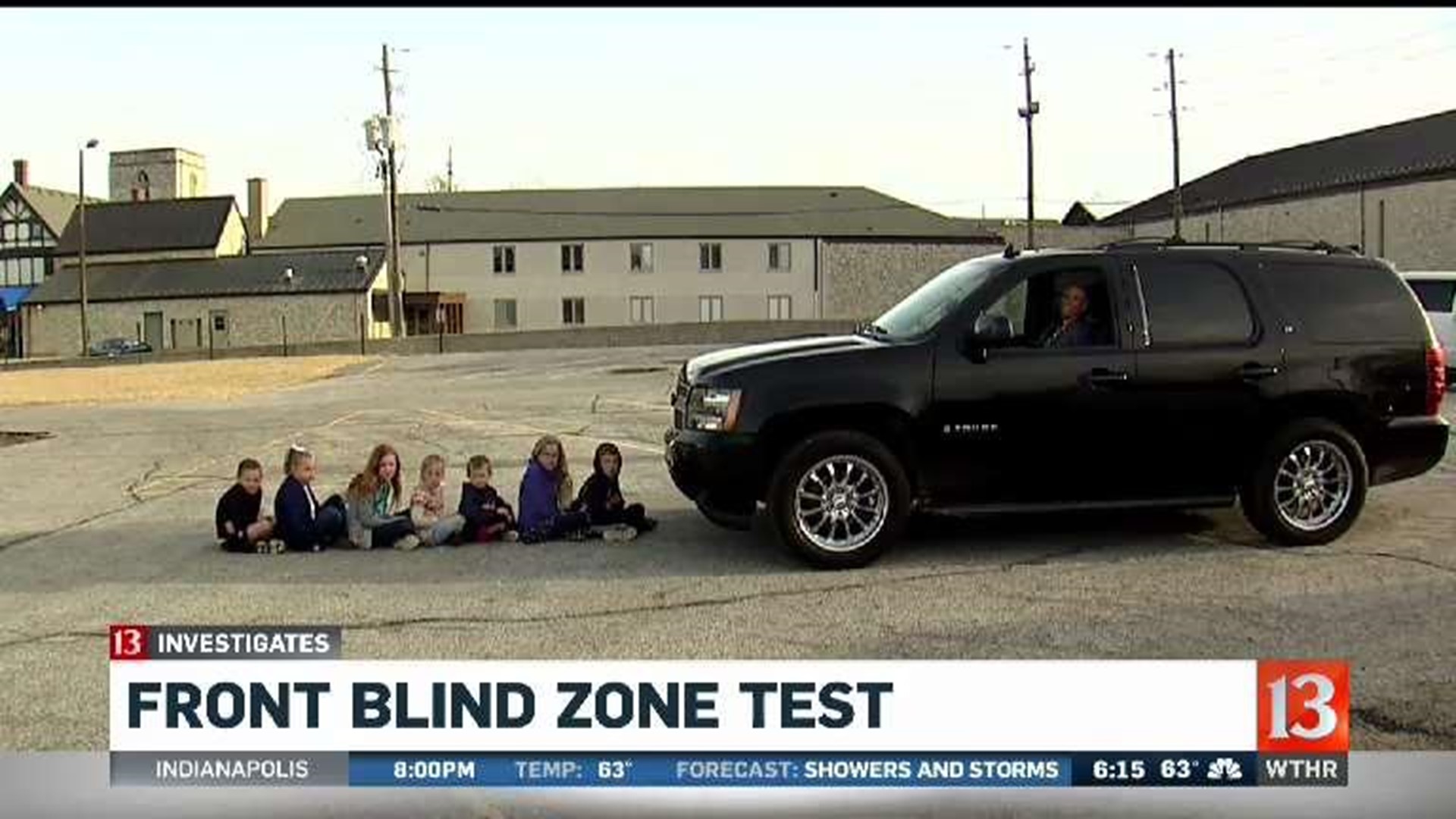INDIANAPOLIS (WTHR) — Millions of popular vehicles have a hidden blind spot that puts children at an increased risk of being injured or killed. That large blind zone, located directly in front of the vehicles, has contributed to hundreds of deaths and thousands of injuries, according to safety advocates who are now trying to warn consumers.
“Can you even imagine killing your own child because you couldn’t see them?” asked Janette Fennell, president and founder of KidsAndCars.org, an organization that tracks vehicle-related accidents involving children. “I think very few people understand that this blind zone exists, and there’s a huge danger when these vehicles start moving forward.”


KidsAndCars has been tracking the emergence and rapid increase of what it calls “frontover” accidents: accidents involving children who are struck while they are in front of a slow-moving vehicle.
Fennell believes a trend toward larger vehicles, which tend to have larger front blind zones, and away from family sedans has played the most dramatic role in the rising statistics.
“As a country, we really are moving to just producing SUVs, trucks and minivans,” she said. “Everyone has the bigger vehicles, so the likelihood of this happening just gets higher and higher, and this problem is only going to get worse.”
Tragedies strike Indiana
Indiana has seen its share of tragic frontover accidents. A 7-year-old Mishawaka boy was killed last summer when a neighbor struck him as she attempted to pull her SUV into the driveway. On the west side of Indianapolis, a 2-year-old girl was hit and killed by the driver of a SUV who did not see her in the parking lot of a carwash. And 15-month-old Noah Dreblow died when his grandfather attempted to move a van a few feet forward so his grandkids could have more room to play basketball in his driveway.
“It was seconds – seconds -- and it happened,” said Noah’s mother, Erica Boyer. “Noah loved basketballs. He saw one in the driveway, and he ran after a basketball and my dad had no idea what had happened, didn't see him. He didn’t even feel the bump of hitting him.”


Boyer recalls getting a call at work telling her to rush to her parents’ house, where she learned paramedics had declared Noah dead at the scene of the accident. “I was greeted by two sheriffs and a state trooper and I said, ‘Just tell me my baby is ok.’ And they said, ‘We can't do that.’ That’s when I knew,” the mother told WTHR. “Your life changes in an instant.”
“We really feel we can see what’s in front of us, and if you tell somebody they can’t see eight feet in front of their vehicle, they think you’re crazy,” said Amber Rollins, who maintains the national injury and fatality database for KidsAndCars. “Unfortunately, not a day goes by that we don’t add a child to our database.”
That database shows each year at least 3,000 children are injured and an average of nearly 60 kids are killed in frontover accidents in the United States. KidsAndCars tracked 575 frontover deaths over the past 10 years, compared to 304 deaths in the prior decade– an increase of 89 percent.
Rollins said she suspects the actual number of frontover accidents nationwide is much higher than what her organization has tracked through media and police reports because many frontovers that do not result in a fatality go unreported.
“We think of these things as freak accidents, but they’re happening much more often than people think,” she explained. “The worst thing for me is when a parent calls and says ‘Why didn’t you tell me this could happen to me? If only I had known about that front blind zone.’”
Because many drivers are unaware of the danger surrounding frontover accidents, 13 Investigates conducted several demonstrations to help illustrate the significant size of front blind zones in large vehicles. Those demonstrations shocked drivers, unaware they could not see objects directly in front of their SUVs.
“Absolutely terrifying” test results
Haven Hutchens said she and her three children travel a lot, so they love the room and the view inside their spacious 2011 Chevy Tahoe.
“I like sitting up higher off the ground, especially navigating through city streets,” the trauma nurse told WTHR. “I don’t feel like I tend to have too many blind spots with it.”
Hutchens agreed to participate in a test to determine the size of her front blind zone. With the help of family and neighbors, WTHR lined up children in front of her parked Tahoe, and Hutchens agreed to alert us at the first sign of a child. As she watched one child after another move toward the front of her vehicle to take a seat on the pavement, Hutchens expressed surprise.
“I can’t see any of them. That’s shocking,” she said after the fifth child sat in front of her SUV.


“That’s super scary,” she added as two more kids joined the line of children. “I still can’t see them.”
It wasn’t until an eighth and then a ninth child joined the experiment that Hutchens could see the very top of a child’s head, warning her of the potential danger hidden directly in front of her. The blind zone in front of her SUV stretched nearly ten feet from the front bumper.
“Oh my gosh, it’s absolutely terrifying,” she said after the test was completed. “That is really eye-opening. I had no idea that the blind spot was that bad.”
The blind zone in front of other vehicles is even larger.
Lindsey Berry drives a Cadillac Escalade, which provides plenty of passenger room for her four kids. But outside the vehicle, there is plenty of room for a child to get overlooked in a front blind zone. During WTHR’s experiment with Berry behind the wheel, a dozen children sat in a single-file line in front of her Escalade without being detected. She couldn't see any of them.
“That is so scary," Berry said during the demonstration, which included lots of kids from her neighborhood. “This is just mind blowing. I can't believe it.”
The test ended when Berry got a glimpse of the thirteenth child who sat in front of her SUV. That child was 15 feet away from her front bumper.
“I'm in shock and I think this is very alarming,” she said. “I like having that vision being up high, but at no point did I realize it was 15 feet in front of me that was blocked. I’m still trying to wrap my head around the fact there’s 13 children lined up in front of me right now. It’s a mother’s worst nightmare.”
Minivans, SUVs and pick-up trucks


13 Investigates measured the front blind zones of many popular vehicles, from family sedans and minivans to large SUVs and full-size pickup trucks.
The blind zones can vary widely based on a number of factors, such as the height of the driver, the size of the object in front of the vehicle, the position of the driver’s seat, and the incline (or decline) of the driving surface. To minimize those variables, WTHR measured each vehicle’s blind zone on a flat surface using a 5 feet 4 inch driver (the average height of a woman in the United States) and a 29 inch traffic cone (the approximate height of a 12-month-old). The testing was also conducted with the driver in two different seating positions.
The test results show most SUVs, minvans and pickup trucks have a front blind zone measuring between five and 10 feet – two to three times larger than the front blind zones of most sedans and compact cars – when a driver sits in a normal seating position. Some larger SUVs and pickups have grills and hoods that measure more than four feet off the ground, which is taller than an average 7-year-old child.
While the larger vehicles featuring higher seats may improve the ability of drivers to see objects at a distance, their larger front blind zones mean impaired visibility at close distances directly in front of the vehicles.
“These are important and eye-opening demonstrations, and they help people understand that a child could be there and they would have no idea,” Rollins said.
Cameras see what you can’t
More than a decade ago, government regulators took drastic action to address a similar problem: children being run over, injured and killed due to blind zones behind vehicles. Since then, automakers have been installing rear-facing cameras on most of their cars and trucks, and last year those cameras became mandatory on all new vehicles sold in the Unites States. As a result, the number of backover injuries and deaths in the U.S. has plummeted.
To combat front blind zones, some automakers are now offering front-facing cameras to help drivers detect hidden objects in front of them. While the number of vehicles with front-camera technology has increased steadily in the past three years, those cameras remain optional equipment on most new vehicles. The vast majority of vehicles currently on the road do not have them.
Chelsea Ohlemiller said a front camera was one of the motivating factors behind her decision to purchase a new Chevy Traverse.
“We have cameras in both the front and back, and I 100 percent rely on these cameras,” she told WTHR. Ohlemiller did not realize how important her front-facing camera is until she participated in a WTHR test. It revealed that while she is in the driver seat, Ohlemiller was unable to see her children playing in the driveway eight feet in front of her vehicle without the camera in operation.
“I cannot see them at all. It's actually getting me a little emotional because I know they're there and I absolutely cannot see them,” she said.
Ohlemiller is relieved she has a front camera on her SUV, but after learning about front blind zones, she is nervous that her three children will be around many vehicles that are not equipped with the same technology.
“It makes me think about all the places they’ll be where there are vehicles that do not have those cameras, and you would not be able to see the kids, and that’s extremely concerning,” she said.
Even in SUVs with a front camera, there can be an issue with how they operate. Lindsey Berry has one on her Cadillac Escalade, but she’s driven the SUV for months without ever using it.
“This camera … serves no purpose! It does not come on when you shift into drive, move forward into a slow drive or during parking,” she said. “I did not even know that it was there.”
Nonetheless, some safety advocates believe expanding the availability of front cameras – perhaps even mandating them as standard equipment in all vehicles -- will reduce injuries and deaths associated with frontovers just as rear cameras did for backovers.
“We have the technology to help prevent this. It’s there. We just need people to know it’s there,” Fennell told WTHR.
Preventing another tragedy
Thinking about front-facing cameras, Erica Boyer pauses to think what might have been if the technology had been installed on the van that struck and killed her son.
“I think that could have changed our situation completely,” she said. “I just want [others] to be aware of their surroundings, and don’t ever think it couldn’t happen to you. It can happen in a matter of seconds and it changes your life.”
If your vehicle does not have a front camera, KidsAndCars recommends that you walk in front of your vehicle to check for potential dangers before you get in and start the ignition. And the organization said all toddlers should be accounted for any time someone is arriving or leaving your home to reduce the risk of an unattended child accidentally running into the path of a vehicle.
“We call it Bye-bye Syndrome. Daddy leaves to run to the store to buy some milk, walks out the front door and a toddler follows behind to say bye-bye. They see daddy but daddy can’t see them, and it happens just that fast,” Fennell said. “They have no concept of the danger, and with so many big vehicles and these big blind zones, it’s something we all need to be thinking about.”
To see the full list of vehicles WTHR compared in the blind zone test, click here.

